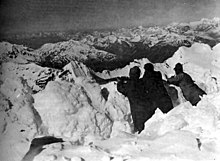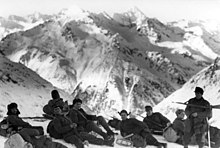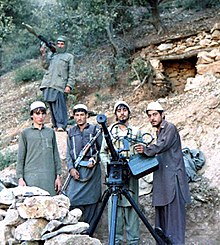Mountain War
As mountain warfare those military conflicts are referred to in mountains play.
Special features of the mountain war
The mountain war is characterized by the obstacle effect of the difficult terrain, which channels troops and supplies movements of the enemy, but also their own, slows them down and impedes them. Armies were limited to using the existing traffic routes until the 20th century . A mutual support of troops moving on parallel paths could therefore not take place on the one hand, on the other hand troop movements could be prevented relatively easily by blocking the traffic routes. In mountain warfare, the numerical and technical superiority of an opposing army can also be compensated for by clever use of the terrain.
The traffic routes (movement lines for combat troops and logistics) can often be effectively blocked by relatively weak forces in favorable positions. An example of this is the battle of Thermopylae , in 480 BC. BC a relatively small Spartan force under Leonidas I stopped a far superior Persian force. At the same time, this defensive effect can be neutralized by a possible evasion of the defender's positions, as happened in the battle of Thermopylae. In order to be able to really block the valley, if necessary, the adjacent heights must also be controlled, otherwise troops in the valley will be attacked from there. For mountain warfare, the principle applies: “Whoever owns the heights controls the valleys.” Overall, mountain warfare requires light, specially trained and equipped troops and tactics that exploit the difficulties of the terrain.
History of the Mountain War
Antiquity
In the history of military tactics , the tactics of the Greeks were shaped by the phalanx . This required a certain amount of space and a terrain that was as unproblematic as possible, since even minor mistakes by individuals would have meant penetration by the enemy and thus a collapse of the entire formation. The Roman manipulation tactics also required a certain minimum space to be able to develop an effect. This is often not the case in the mountains. The lack of space led, for example, in the battle of Noreia to the defeat of the Roman troops against the Cimbri , Teutons and Ambrones . Therefore, warfare in the mountains was avoided whenever possible.
middle Ages
The medieval tactics was heavily on the development of the armored knight marked vastly superior fighter than in the pitched battle to the foot soldiers. These troops were not suitable for use in the mountains, as the battle of Roncesvalles showed very early in 778 , in which the lightly armed Basques were able to defeat the mounted Franks , as they lacked maneuvering space. The Battle of Morgarten in 1315 also represented the deliberate exploitation of the terrain, as the knight army Leopold I was attacked by the federal troops in a ravine where the heavy cavalry could not come into play.
Early modern age
After the Battle of Morgarten, for the outcome of which the use of the infantry armed with halberds was important in addition to the exploitation of the area , the tactics from the 15th to the 16th century were determined by the gang of mercenaries and their pikemen . This form of combat also required a certain amount of space. The warfare was not adjusted to the mountainous terrain and so it was more a means of partisan struggle . This is evidenced by the fact that in the past political borders were seldom at pass heights , but rather the stronger party set up an outpost on the other side of the pass in inhabited areas (e.g. Urnerboden as Urner outpost against Glarus ; Gmünd as Salzburg outpost against Carinthia ).
18th and 19th centuries
As long as the war was dominated by the arranged field battle in a rigid order of battle and high mountain regions were generally considered impassable, warfare there took place at most on passes.
In the course of the 18th century, several factors emerged that favored the emergence of a force specifically geared towards mountain warfare:
- In Denmark-Norway, two light infantry companies skiløper were set up as early as 1709 in the Great Northern War , but skis as a civilian and military means of transport spread only slowly.
- The light infantry, which emerged in the middle of the century, fought in open formation and could therefore also be used in mountainous terrain.
- Alpinism, which emerged in the 1880s, opened up access to mountain formations that had previously been considered invincible.
- With the subsequent transition from the mercenary army to the civil army, larger units of line troops could also be deployed in mountain regions without too many soldiers using the confusing terrain to desert.
With a few, mostly improvised exceptions, these new possibilities for waging war were initially unused. The mountains were long considered unsuitable for acts of war. The leaders and troops were not trained for it. Clausewitz viewed the mountains as a secondary theater of war, on which no decision could be reached and was therefore only important as a refuge for the weak.
In the 19th century, fighting in the mountains gained in importance, initially in the form of guerrilla warfare , beginning with the Napoleonic Wars on the Iberian Peninsula (1807–1814), in which the Spanish irregulars were inferior to the French troops and retreated to the mountains. There they could cause heavy losses to the French army. For his part, Napoleon recruited three battalions of Chasseurs de Montagne from the French mountain departments on August 6, 1808 . These mountaineers were supposed to be on patrol on both sides of the Pyrenees border and prevent Spanish guerrillas from infiltrating . The soldiers of these associations, which were disbanded in 1814, had no mountaineering training or equipment.
Another example of a successful mountain operation during this time is the conquest of the "Leutasch-Schanz" near Mittenwald in 1805 by the French. The neighboring fortress "Porta Claudia" near Scharnitz has secured the gateway to Austria since the Middle Ages. After bypassing the so-called “Franzosensteig” on the Grünkopf (1,587 m), French troops reached their rear, so that on November 5, 1805, Marshal Ney entered Innsbruck with his army.
In the Battle of Bergisel in 1809 the Tyroleans under Andreas Hofer fought against Bavarian, French and Saxon troops and achieved not inconsiderable successes.
The Carlist Wars within Spain were essentially fought as partisan wars in the mountains. However, in these clashes, the partisan units were still dependent on regular troops in order to have lasting success, whose tactics were not designed for mountain warfare.

During the British withdrawal under General Elphinstone in the First Anglo-Afghan War , the British armed forces were wiped out by Afghan tribal troops, taking advantage of the Afghan mountainous region. It was similar with the resistance of the Caucasian peoples under Imam Shamil . In this dispute, the greater mobility of the local fighters was deliberately and successfully used against the Russian troops over a long period of time.
It took some time, however, until the need for a force trained and equipped for mountain warfare and its capabilities was recognized. Mountain troops in the true sense of the word did not emerge until the second half of the 19th century, when the construction of light and dismountable guns and the use of carrying animals made it possible to equip these troops with the necessary artillery and supply capacities. As a rule, existing units of the light infantry were used as core troops; mountain dwellers were primarily used to replace them. In 1872 Italy founded the Alpini troop , initially with 15 companies , followed by France in 1888 with the formation of the Chasseurs alpins .
20th century
1906 were in Austria-Hungary two Tyrolean country shooters converted regiments to high mountain troops. In 1911, the Swiss Confederation began to form a mountain corps.
First World War

The hour of the mountain war struck unexpectedly in the First World War. The mountain war of 1915–1918 between Austria-Hungary (with German help) and Italy (since 1917 with support from the other allies ) was fought as a trench war. Five main fronts can be distinguished: between Stilfser Joch and Lake Garda , from Lake Garda to Kreuzbergsattel near Sexten , on the ridges of the Carnic and Julian Alps , on the Isonzo and on the Piave-Grappa front. The positions were partially at almost 4000 m altitude, z. B. on the Ortler . The mountain war of 1915–1918 can be seen as a one-off, as two armies never again engaged in a year-long positional war in the mountains.
see also: Company Lawine , Austria-Hungary's South Tyrol offensive 1916
Second World War
During the Second World War there were individual battles in the mountains, for example in Norway , the Balkans , the Caucasus , the Western Alps and the Apennines . Care was taken, however, to lead the war in a more “flexible” manner and to avoid the freezing of the fronts, even if they accepted their own retreat. In addition, the mountains played a role in the partisan war (especially against the Titopartisans ) and finally in the final stages of the war through the Alpine fortress .
Middle East
Major parts of the First and Second Indo-Pakistani War for Kashmir were fought as a mountain war. The Kashmir conflict in Kashmir, a disputed region in the Himalayas between India and Pakistan , continues to this day, and China was also involved in the Sino- India border war .
The Soviet intervention in the Afghan civil war failed, not least because of the skilful use of Afghanistan's mountain topography . The current Afghanistan conflict ( Operation Enduring Freedom or ISAF deployment) is also primarily an asymmetrical battle in the mountains. Forces of the Taliban and Al-Qaeda are using the advantages of the mountains against the troops of NATO and the Afghan government. For example, the problems with Operation Anaconda in 2002 resulted from the fact that NATO, unlike its opponents, was not adapting itself adequately to the demands of the mountain war.
middle East
After Mount Hermon, which was occupied by Israel in the Six Day War in 1967, together with an important Aman listening post in the Yom Kippur War , was recaptured by Syrian airborne commandos and could only be captured again by the Israeli armed forces with losses at the second attempt, the Alpinistim as a special unit for the mountain war. Previously, these tasks were carried out by the scouts of the paratrooper brigade ( Sajeret Zanhanim ) and an alpine train of the Sajeret Matkal . The Alpinistim were also used in the Chouf Mountains during the Lebanon War (1982) . The battle for the Hermon sat down as a war of attrition with the use of snipers and assault teams until spring 2004 with the separation of forces and the deployment of peacekeepers the UN continues.
Mountain troops of different states after their formation
- for Austria see k.k. Mountain Troops and Mountain Troops (Austria)
- for Germany see mountain troops (Germany)
- for France see Chasseurs alpins
- In accordance with its topography and the Reduit strategy , Switzerland has geared significant parts of the Swiss Army to use in the mountains, and larger parts of the ground forces have always been specially equipped and trained for this. In Army XXI , these are three of the seven infantry brigades, with Mountain Infantry Brigades 9 , 10 and 12 .
- for Italy see Alpini
- on Poland see Podhale-Schützen
- In the British armed forces , the skills for mountain combat are based in the commandos of the Royal Marines , as the British Isles hardly have any mountains and alpine knowledge is required there primarily for landing operations on rocky coasts.
- for the USA see 86th Infantry Brigade , originally also the 10th Mountain Division
- on Israel see Alpinistim
- in the Chilean Army with the 3rd Mountain Division in Valdivia with pack units
- the 5th, 6th and 8th Mountain Brigade in the Argentine Army .
Representation in literature and film
In particular, the mountain war of the First World War inspired several novels. Ernest Hemingway processed his experiences at the front in In Another Land (1929, filmed in 1932 and 1957 ), Luis Trenker wrote a. a. Berge in Flammen (book and film 1931) and Sperrfort Rocca Alta (1937), Gino Cornali Eine von drüben (1935) and Emilio Lussu's novel A Year on the Plateau (1938, German edition 1968) came to the cinemas in 1970 as a battalion of the lost . The Italian hero in Mark Helprins' A Soldier from the Great War (1991) took u. a. in the mountain war of the First World War.
literature
- Heinz von Lichem : Mountain War 1915-1918 . 3 volumes, Bozen 1980/81.
- Erwin Rommel : Infantry attack , Potsdam 1937.
- Walther Schaumann : From the Ortler to the Adria - Dall 'Ortles all' Adriatico. The southwestern front in pictures - Immagini del fronte italo-austriaco 1915-1918 ; Mayer & Comp, Vienna, 1993. ISBN 3-901025-20-0 .
- Josef Baumann: The warfare in the high mountains. In: Journal of the German Alpine Association / Journal of the German and (the) Austrian Alpine Association , year 1892, (Volume XXIII), pp. 45–83. (Online at ANNO ).
Web links
- Uli Mößlang: Image and map archive of the mountain fortresses, additional information
- Keyword mountain war at the end of the 19th century . In: Meyers Konversations-Lexikon . 4th edition. Volume 6, Verlag des Bibliographisches Institut, Leipzig / Vienna 1885–1892, p. 973.
- Friedrich Engels, warfare in the mountains then and now
- Burning Southern Front - The Mountain War 1915-1918 - Austria-Hungary's battle in the First World War
Individual evidence
- ↑ Colonel CO Munthe: The Great Northern War 1709-1719, p. 6ff, English translation from Den Norske Hær Indtil 1814, Kristiania, 1914 ( page no longer available , search in web archives ) Info: The link was automatically marked as defective. Please check the link according to the instructions and then remove this notice. Accessed June 27, 2008.
- ↑ Michael Wiener: Alpinistim: Mountain and Winter Combat in the Israeli Army in Barett 2/2001 pp. 45–47.

